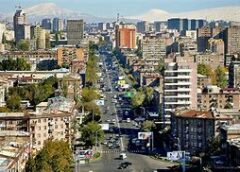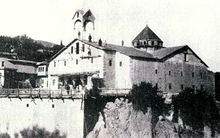Démographie | Chronique des Arméniens d'Arapkir
Cet article, qui se concentre sur la communauté arménienne d'Arapkir, est le résultat d'années de travail acharné de Todd Shaphren (Parisien). L'article concerne spécifiquement le nombre d'Arméniens Arapkir dispersés à travers le monde après la Première Guerre mondiale.
Tout au long des années qui ont suivi le génocide, l'Union compatriote arapgir a fait des efforts réguliers pour maintenir des listes d'arméniens arapgir connus et pour identifier leurs lieux de résidence. Todd Shaphren a rassemblé et analysé ces listes et les a rendues accessibles à nos lecteurs. De plus, il a donné un aperçu des méthodologies des recensements effectués à diverses époques.
Nous tenons à exprimer notre gratitude à Todd pour son travail assidu, ainsi que sa patience face aux défis qui ont causé de multiples retards dans la publication de cet article.
Voici le lien pour la page.
https://www.houshamadyan.org/mapottomanempire/vilayetofmamuratulazizharput/kaza-of-arapgir/locale/demography-2-list-of-survivors.html
L'article a été traduit en arménien et en turc respectivement par Vartan Tashjian et Arlet İncidüzen.
———————————————————————————————————————————————
Arapgir (Armenian: Արաբկիր; Kurdish: Erebgir[3]) is a town and district of Malatya Province, Turkey. As of 2000 it had a population of 17,070 people.
It is situated at the confluence of the eastern and western Euphrates, but some miles from the right bank of the combined streams. Arapgir is connected with Sivas by a chaussée, prolonged to the Euphrates river. The present town was built in the mid-19th century, but about 2 miles north-east is the old town, now called Eskişehir ("old city" in Turkish).[4]
History
This territory is a part of historic Lesser Armenia. The old town of Arapgir was founded by the Armenian King Senekerim-Hovhannes Artsruni in 1021, who had exchanged his kingdom of Vaspurakan for estates in the central lands of the Byzantine Empire.[5]
Demographics
Arapgir town is populated by Kurds.[6] In descending order of population, the district is populated by Turks, Kurds, and Armenians. Armenians used to be the second largest ethnic group after Turks, constituting one third of the population, but most of the population was wiped out during the Armenian genocide.[7]
Composition
| Settlement | Composition |
|---|---|
| Arapgir town | Kurdish[6] |
| Aktaş | Turkish[8] |
| Alıçlı | Turkish[9] |
| Boğazlı | Turkish[8] |
| Bostancık | Kurdish[10] |
| Budak | Turkish[8] |
| Çakırsu | Kurdish[10] |
| Çaybaşı | |
| Çiğnir | Turkish[8] |
| Çimen | Turkish[8] |
| Deregezen | Kurdish[10] |
| Düzce | Turkish[11] |
| Esikli | Kurdish[10] |
| Eski Arapgir | Turkish[12] |
| Eynir | Turkish[11] |
| Gebeli | Kurdish[10] |
| Gözeli | Turkish[13] |
| Günyüzü | Turkish[9] |
| Kayakesen | Turkish[14] |
| Kaynak | Kurdish[10] |
| Kazanç | Kurdish[10] |
| Kılıçlı | Kurdish[10] |
| Konducak | Kurdish[10] |
| Koruköy | Turkish[13] |
| Meşeli | |
| Onar | Turkish[9] |
| Ormansırtı | Turkish[13] |
| Pacalı | Kurdish[10] |
| Pirali | Kurdish[10] |
| Şağıluşağı | Kurdish[10] |
| Selamlı | Turkish[9] |
| Sinikli | Kurdish[10] |
| Sipahiuşağı | Kurdish[10] |
| Suçeyin | Kurdish and Turkish[8] |
| Sugeçti | Kurdish[15] |
| Tarhan | Kurdish[16] |
| Taşdelen | Kurdish and Turkish[10] |
| Taşdibek | |
| Ulaçlı | Kurdish[10] |
| Yaylacık | Kurdish[17] |
| Yazılı | Kurdish[10] |
| Yeşilyayla | Turkish[13] |
| Yukarı Yabanlı | Turkish[9] |
History
According to Donald Quataert, Arapgir in the 1880s was made up of 4,802 Muslim and 1,200 Armenian households, with a total population of about 29,000 persons.[18] According to a METU study citing Nejat Göyünç, the city population was about 20,000 in 1911, of which more than half of the population was Armenian Christians and the rest were Muslim.[19][20] Differing sources present differing pictures for the respective shares of ethnicities within the weavers' community. The Armenian population is reported to have suffered severely during the Hamidian massacres of 1895,[21] although, in this regard, Donald Quataert notes, with textile exports back to normal levels a year after the turmoil, in 1896, either all weavers were Muslims after all, or few Armenian weavers were killed, displaced or disrupted during the troubles.
On the eve of World War I, there were about 9,523 Armenians (1,300 houses) and 6,774 Turks living in Arapgir.[22] After the 1915 Armenian genocide, most of the Armenian population of Arapgir was killed or deported.[23]
Churches, mosques and other buildings
Armenian Cathedral of Arapgir.
See also: Cathedral of Arapgir
Before the Armenian genocide Arapgir had seven Armenian Apostolic churches: Surp Astvadzadzin (Holy Mother of God) Church, not to be confused with the cathedral, Grigor Lusavorich (Gregory the Illuminator) Church, Surp Kevork Church, Surp Hagob Church, Surp Nshan Church, Surp Pilibos Arakel (St. Philip the Apostle) Church, Surp Sarkis Church, There were, also, one Catholic Surp Prgich (Holy Saviors) Church and one Protestant Cuğran Church.[24] There were also more than 10 schools in the town. Little is left of pre-war Arapgir, but there are still some old houses that have survived, which are Armenian origin. The town also contains the ruins of a castle, several Seljuk mosques,[4] old cemetery and silver mines.
People from Arapgir
- Abdullah Cevdet
- Aram Achekbashian (1867-1915), Hnchak politician
- Cemal Azmi (1868-1922), Ottoman politician
- Vahagn Davtyan, (1922-1996), an Armenian writer
- Khajag Barsamian, born 1951, the primate of Diocese of Armenian Church of Eastern America
- Zehra Bilir (1913-2007), famous singer of Turkish folk songs known as "Türkü Ana" (Mother of Folk Songs). After her death, it was revealed she was born Armenian by the name of Eliz Surhantakyan.
See also
References
- ^ "Area of regions (including lakes), km²". Regional Statistics Database. Turkish Statistical Institute. 2002. Retrieved 2013-03-05.
- ^ "Population of province/district centers and towns/villages by districts – 2012". Address Based Population Registration System (ABPRS) Database. Turkish Statistical Institute. Retrieved 2013-02-27.
- ^ Avcıkıran, Adem (2009). Kürtçe Anamnez, Anamneza bi Kurmancî (in Kurdish and Turkish). p. 55.
- ^ Jump up to:a b
 One or more of the preceding sentences incorporates text from a publication now in the public domain: Hogarth, David George (1911). "Arabgir". In Chisholm, Hugh (ed.). Encyclopædia Britannica. Vol. 2 (11th ed.). Cambridge University Press. p. 253.
One or more of the preceding sentences incorporates text from a publication now in the public domain: Hogarth, David George (1911). "Arabgir". In Chisholm, Hugh (ed.). Encyclopædia Britannica. Vol. 2 (11th ed.). Cambridge University Press. p. 253. - ^ Kévorkian, Raymond H. and Paul B. Paboudjian, Les Arméniens dans l’Empire Ottoman à la veille du génocide. Paris: Editions d’art et d’histoire, 1992, p. 375.
- ^ Jump up to:a b Peter Alfred, Andrews; Benninghaus, Rüdiger, eds. (1989). Ethnic Groups in the Republic of Turkey. p. 338.
- ^ Olcay, Cem Bircan (2014). "Malatya Arapgir Ağzı (İnceleme – Metinler – Sözlük)" (PDF). Hacettepe Üniversitesi Sosyal Bilimler Enstitüsü: Türk Dili ve Edebiyatı Anabilim Dalı (in Turkish): 12.
- ^ Jump up to:a b c d e f Andrews, Peter; Benninghaus, Rüdiger (2002). Ethnic Groups in the Republic of Turkey: Supplement and Index. p. 96. ISBN 9783895002298.
- ^ Jump up to:a b c d e "Günyüzü Köyü" (in Turkish). Archived from the original on 17 December 2016. Retrieved 13 October 2021.
- ^ Jump up to:a b c d e f g h i j k l m n o p q Andrews, Peter; Benninghaus, Rüdiger (2002). Ethnic Groups in the Republic of Turkey: Supplement and Index. p. 121. ISBN 9783895002298.
- ^ Jump up to:a b "Düzce Köyü". Archived from the original on 17 December 2016. Retrieved 13 October 2021.
- ^ "Eski Arapgir Köy". Tarih Gezisi (in Turkish). 2020. Retrieved 13 October 2021.
- ^ Jump up to:a b c d Ertürk, Kenan (2000). "Malatya'nın etnik yapısının siyasi hayata etkileri" (in Turkish): 131.
- ^ "Kayakesen Köyü". Archived from the original on 17 December 2016. Retrieved 13 October 2021.
- ^ Çiplak (2011). "Music and Identity in Atma tribe". ITU Institute of Social Sciences. Istanbul Technical University: 34.
- ^ "Tarhan Köyü". Archived from the original on 17 December 2016. Retrieved 13 October 2021.
- ^ "Yaylacık Köyü". Archived from the original on 17 December 2016. Retrieved 13 October 2021.
- ^ limited preview Donald Quataert; et al. (1993). Ottoman Manufacturing in the Age of the Industrial Revolution. Cambridge University. pp. 86–99.
- ^ Nejat Göyünç (1983). Osmanlı idaresinde Ermeniler [Armenians in the Ottoman Administration] (in Turkish). Gültepe Yayn. Ankara.
- ^ Pınar Kundil. "The Armenian question according to Takvim-i Vekayi (1914-1918)" (PDF). Middle East Technical University, Ankara. Retrieved 1 May 2017.
- ^ Hewsen, Robert H., "Golden Plain: The Historical Geography of Tsopk/Kharpert," in Armenian Tsopk/Kharpert, ed. Richard G. Hovannisian. Costa Mesa, CA: Mazda Publishers, 2002, p. 49.
- ^ Kévorkian and Paboudjian, Les Arméniens dans l’Empire Ottoman, pp. 375-76.
- ^ Raymond Kévorkian. The Armenian Genocide: A History (London: I.B. Tauris, 2011), pp. 402-407.
- ^ Kévorkian and Paboudjian, Les Arméniens dans l’Empire Ottoman, p. 376.
 This article incorporates text from a publication now in the public domain: Chisholm, Hugh, ed. (1911). "Arabgir". Encyclopædia Britannica (11th ed.). Cambridge University Press.
This article incorporates text from a publication now in the public domain: Chisholm, Hugh, ed. (1911). "Arabgir". Encyclopædia Britannica (11th ed.). Cambridge University Press.



